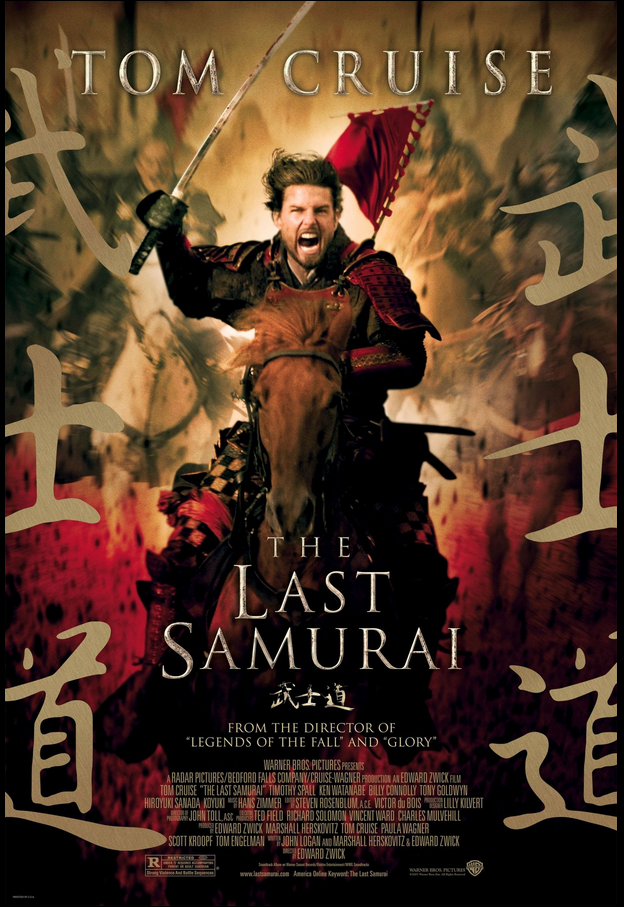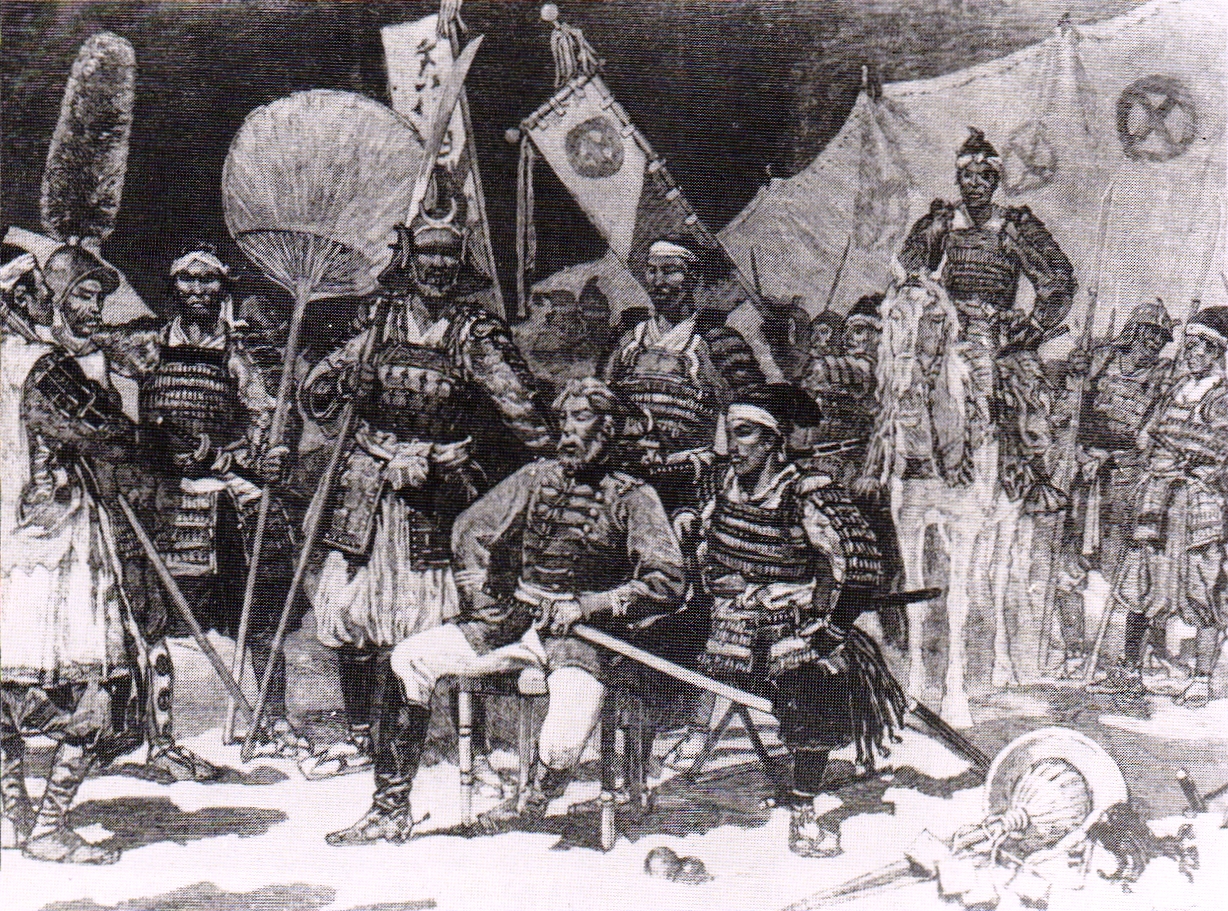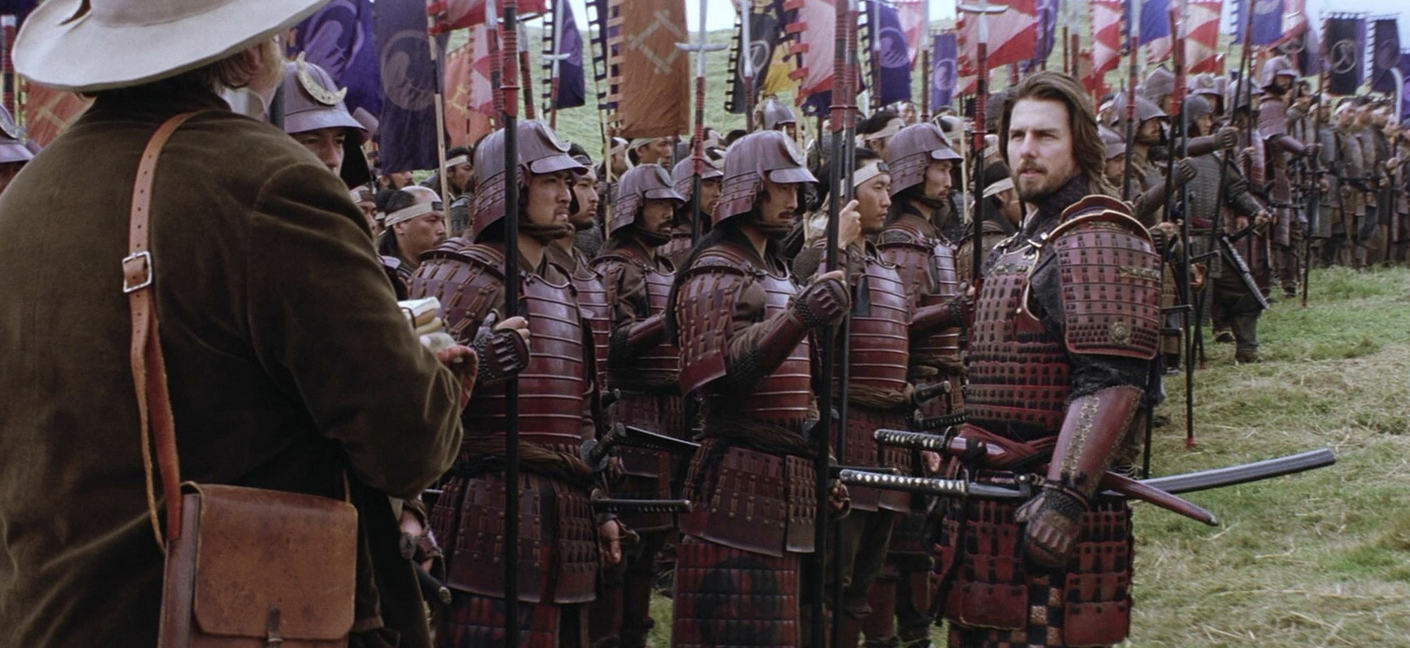My Review of The Last Samurai a film with a sublime and epic score that spurs Cruise to do his best. / Mi Reseña de El Ultimo Samurai una película con una partitura sublime y épica que estimula a Cruise a dar lo mejor de sí mismo. |ENG-ESP|

The so-called Far East and the samurai, along with Japan, have at the cinematic level a kind of link that intertwines with imperial honor.
The traits of a feudal society, devotion to the emperor and suicide by harakiri when certain values are compromised in such a way that it is impossible to recover them.
The figure of Toshiro Mifune, the most emblematic Japanese actor in the characterization of these characters, has been a constant.
For this reason, it caused a certain astonishment when an actor as far removed from this type of role as Tom Cruise decided to play the main character in The Last Samurai, a film directed by Edward Zwick. It manages not only to discover a new facet in the acclaimed American actor, but also manages to get one of the best film products of the genre.
The new modern world that meets the values of the old feudal world and still governed by certain principles of loyalty that end only with death. The katana or samurai sword, an emblem that rivals modern firearms.
In this case, the mythical Japanese figure of Toshiro Mifune is replaced by Ken Watanabe, who gives an excellent performance in the midst of a Japan that is trying to break away from millenary traditions to become part of the new political games of world power.
Nominations for four Oscars and three Golden Globes speak of an extraordinary film that is - even today and almost 20 years after its release - a landmark, a film that made cinema history.

El llamado Lejano Oriente y los samuráis, junto con el Japón, tienen a nivel cinematográfico una especie de vínculo que se entrelaza con el honor imperial.
Los rasgos de una sociedad feudal, la devoción al emperador y el suicidio por harakiri cuando ciertos valores quedan comprometidos de tal modo que es imposible recuperarlos.
La figura de Toshiro Mifune, el actor japones más emblemático en la caracterización de estos personajes, ha sido una constante.
Por ese motivo causó un cierto estupor cuando un actor totalmente alejado de este tipo de roles como Tom Cruise decidió encarnar el personaje principal de El Último Samurái, pelicula dirigida por Edward Zwick. Que logra no solamente descubrir una faceta nueva en el consagrado actor estadounidense, sino que además logra obtener uno de los mejores productos cinematográficos del género.
El nuevo mundo moderno que se encuentra con los valores del viejo mundo feudal y gobernado todavía por ciertos principios de fidelidad que terminan solo con la muerte. La katana o espada de los samuráis, todo un emblema, que rivaliza con las modernas armas de fuego.
En este caso, la mítica figura japonesa de Toshiro Mifune es reemplazada por Ken Watanabe de excelente interpretación en medio de un Japón que trata de desprenderse de tradiciones milenarias para entrar a hacer parte de los nuevos juegos políticos de poder mundiales.
Las nominaciones a cuatro Óscar y tres Globos de Oro hablan de una película extraordinaria que es -aún hoy y a casi 20 años de su estreno- un punto de referencia, una película que hizo historia en el cine.

At the end of the 19th century, more precisely, the plot is set in the year 1876. Nathan Algren (excellent performance by Tom Cruise) is a former U.S. Army captain who counts on his service record having served as commander of the 7th Cavalry Regiment in the war against the Native Americans.
Overwhelmed by remorse for having ordered an inhumane reprisal against a Native American village by destroying the entire town (which is not by chance an analogy to the real Wounded Knee massacre of December 29, 1890 ordered by General Custer) he submerges his sense of guilt in alcohol.
Suddenly he is presented with a life-changing opportunity when he is hired by the Japanese Empire to train the Meji Emperor's army in its fight against the rebellious samurai. While as a kind of mercenary he has the chance to leave behind a military past marked by continuous nightmares and innocent deaths.
When he arrives in Japan he discovers to his surprise that in reality it is a country divided in two. On the one hand a country that day by day is discovering a new technology of which he had not even felt to speak of hand in hand with a modern trade marked with increasingly frenetic rhythms and in which the money acquires more and more importance.
On the other hand, he also encounters a semi-feudal Japan with a total cult of the samurai philosophy. And it is here, in this environment, where Captain Algren will have to develop his work as a military instructor. Teaching peasants to handle weapons (to people who had never even seen a rifle in their lives) to defend themselves against the incursions of the samurai rebels. It is a project destined to fail if it is not elaborated with patience. And patience is what the emperor lacks as he wants to put an end to the samurai rebellion as quickly as possible.
A hasty and desperate decision can only lead to defeat at the hands of the samurai army commanded by General Katsumoto (extraordinary performance by Ken Watanabe). Algreen is wounded in battle (great close-ups in slow motion) and is taken prisoner.
When Katsumoto learns who he is, he decides neither to execute him nor to condemn him to permanent captivity, but to force him to integrate into the samurai culture, even if it means humiliating him. And this is what happens in the early days in a rebellious village where he is subjected to mockery and permanently controlled by guards.
Gradually, however, he begins to realize that these barbarians are not the savage and curly people he had heard about in the Japanese imperial palaces. They are people who are trying to rescue a tradition constantly violated and trampled by the emperor's power.
Little by little he begins to understand their ideals, to understand them and to justify them. Little by little he assumes the true role of the samurai, of the philosophy of the sword and of life. He realizes that the purpose of the samurai is not to divide Japan by ruining it, but to avoid the ideals of westernization that are gradually invading it. And he takes their side by deciding to fight alongside them in what will be the final battle.
In fact, the rebel leader himself, Katsumoto, supports a gradual westernization in customs, but without abandoning the ideals of a millenary culture as the emperor's government intends to do. And Algren and Katsumoto go from being irreconcilable enemies to being friends united by the same ideal. In reality, what the film is trying to teach us is that we must not forget our own origins at the cost of a permanent social evolution. Algren will find his redemption as a man destroyed by his own conscience to a man with clear ideals to fight for.
Great music by Hans Zimmer in both peace and war scenes.

Fines del siglo XIX, más precisamente la trama nos sitúa en el año 1876. Nathan Algren (excelente interpretación de Tom Cruise) es un antiguo capitán del ejército estadounidense que cuenta en su foja de servicios el haberse desempeñado dirigiendo el 7º Regimiento de Caballería en la guerra contra los indígenas americanos.
Agobiado por los remordimientos que haber ordenado una inhumana represalia contra una aldea de nativos americanos destruyendo todo el pueblo (lo que no es por casualidad una analogía con la verdadera masacre de Wounded Knee del 29 de diciembre de 1890 ordenada por el general Custer) se sumerge su sentido de culpa en el alcohol.
De repente se le presenta la oportunidad de cambiar vida al ser contratado por el Imperio japonés para entrenar al ejército del emperador Meji, en su lucha contra los samuráis rebeldes. Si bien como una especie de mercenario tiene la posibilidad de dejar atrás un pasado militar marcado por continuas pesadillas y muertes inocentes.
Cuando llega a Japón descubre con sorpresa que en realidad es un país dividido en dos. Por un lado un pais que dia a dia va descubriendo una tecnologia nueva de la cual ni siquiera habia sentido hablar d ela mano de un comercio moderno marcado con ritmos cada vez mas freneticos y en el cual el dinero adquiere cada vez mas importancia.
Por el otro lado tambien se encuentra con un Japon semifeudal con un culto total a la filosofia samurai. Y es aqui, en este ambiente, donde el capitán Algren debera desarrollar su labor de instructoria militar. Enseñar a campesinos a manejar las armas (a gente que ni siquiera habia visto de cera un fusil en toda su vida) para defenderse de las incursiones de los rebeldes samurais. Es un proyecto destinado al fracaso si no se elabora con paciencia. Y paciencia es la que le falta al emperador que quiere acabar con la in surreccion samurai de la manera mas rapida posible.
Una decision apresurada y desesperada solo puede conducir a la derrota a manos del ejercito samurai comandado por el general Katsumoto (extraordinaria interpretacion de Ken Watanabe). Algreen es herido en la batalla (primeros planos estupendos en cámara lenta) y cae prisionero.
Cuando Katsumoto se entera de quien es decide ni ejecutarlo ni condenarlo al cauttiverio permanente, sino obligarlo a integrarse a la cultura samurai, aunque sea a fuerza de humillarlo. Y esto es lo que ocurre en los primeros tiempos en un poblado rebelde donde es sujeto a burlas y controlado permanentemente por guardias.
Sin embargo, de a poco, comienza a darse cuenta que esos bárbaros no son las personas salvajes y curles de los que habia sentido hablar en los palacios imperiales japoneses. Es gente que trata de rescatar una tradicion constemente vulnerada y pisoteada por el poder del emperador.
De a poco comienza a entender sus ideales, a comprenderlos y a justificarlos. Asumiendo de a poco el verdadero rol del samurai, de la filosofia de la espada y de la vida. Se da cuenta que el objeto de los samurai no es dividir el Japón arruinandolo sino evitar los ideales de occidentalizacion que de a poco lo estan invadiendo. Y se coloca de su parte decidiendo luchar junto a ellos en la que será la batalla final.
En realidad el propio jede rebelde, Katsumoto apoya una gradual occidentalizacion en las costumbres, pero sin abandoinar los ideales de una cultura milenaria como pretende hacer el gobierno del emperador. Y Algren y Katsumoto pasan de ser enemigos irreconciliables a ser amigos unidos por un mismo ideal. En realidad lo que la pelicula nos tramsite es que no debemos olvidar nuestros propios origenes a costa de una evolucion social permaente. Algren encontrara su redencion como hombre destruido por su propia conciencia a un hombre con ideales claros por los cuales combatir.
Estupenda la musica de Hans Zimmer ya sea en las escenas de paz o de guerra.

Tom Cruise: Captain / Capitán Nathan Algren
Ken Watanabe: Katsumoto
Billy Connolly: Sergeant / Sargento Zebulon Gant
Hiroyuki Sanada: Ujio
Koyuki Katō: Taka
Masato Harada: Omura
Scott Wilson: Ambassador / Embajador Swanbeck
Seizō Fukumoto: Bob, the taciturn samurai / el samurái taciturno
Shichinosuke Nakamura: Emperor / Emperador Mutsuhito
Shin Koyamada: Nobutada
Shun Sugata: Nakao
Timothy Spall: Simon Graham
Togo Igawa: General Hasegawa
Tony Goldwyn: Colonel / Coronel Benjamin Bagly

It is impossible to watch Edward Zwick's film and not be reminded of old cinema classics such as The Seven Samurai or The Samurai Challenge, which are part of that extensive, extraordinary and unlimited Japanese filmography.
This film belongs to that category of film products with very good reviews, generally very well accepted by the public, with several nominations, but that in the end does not receive any award. Many times the Hollywood Academy Awards have had to do with what is "politically correct" and what is not. Wounded Knee was an example. The military men involved had even been honored with medals for this massacre. It took 111 years for the U.S. Congress to recognize the true entity of the tragedy, strip the military men and women who had received them of their honors and medals, and declare the site a National Historic Landmark.
The U.S. was slow to accept that the war against the Indians had been in many cases a massacre organized by the big railroad companies.
The real life of the samurai (many of whom had originally been peasants) is portrayed with almost maniacal care. With a Tom Cruise, perhaps in his best moment as an actor (he had just made Vanilla Sky, Shattered Glass and Narc).
On the other hand, the film picks up a lot of oriental cinema with the looks, silences and feelings not expressed visually but tangible at every moment.

Es imposible ver el film de Edward Zwick y no recordarse de viejos clásicos del cine con Los Siete Samuráis o El Desafío de los Samuráis que hacen parte de esa extensa, extraordinaria e ilimitada filmografía japonesa.
Esta pelicula pertenece a esa categoría de productos cinematográficos con muy buena crítica, generalmente muy bien aceptadas por el público, con varias nominaciones, pero que al final no recibe ningún premio. Muchas veces los premios de la Academia de Hollywood han tenido que ver con lo "políticamente correcto" y con lo que no lo es. Wounded Knee fue un ejemplo. Los militares involucrados hasta habían sido distinguidos con medallas por esta masacre. El Congreso de los EE. UU. tardo 111 años en reconocer la verdadera entidad de la tragedia, despojar de los honores y medallas a los militares que las/os habían recibido y declarar al lugar como Hito Histórico Nacional.
Los EE. UU. tardaron mucho en aceptar que la guerra contra los indios había sido en muchos casos una masacre organizada por las grandes compañías del ferrocarril.
La verdadera vida de los samuráis (muchos de los cuales habían sido campesinos en sus orígenes) está reflejada con un cuidado casi maniacal. Con un Tom Cruise, tal vez en su mejor momento como actor (venía de hacer Vanilla Sky, Shattered Glass y Narc)
Por otro lado la pelicula recoge mucho del cine oriental con las miradas, silencios y sentimientos no expresados visualmente pero tangibles a cada instante.

| Username | @sunko |
|---|---|
| Translation / Traducción | DeepL |
| Banners | PNGTree - Shopping Thoughts |
| Divider Text / Separador de texto | ThePeakStudio |
| Image Editors / Editores de Imágenes | PhotoFiltre - HeliosPaint |


Congratulations @shunko! You have completed the following achievement on the Hive blockchain and have been rewarded with new badge(s):
Your next target is to reach 1250 upvotes.
You can view your badges on your board and compare yourself to others in the Ranking
If you no longer want to receive notifications, reply to this comment with the word
STOPSupport the HiveBuzz project. Vote for our proposal!
Thank you for your constant contribution to the community @hivebuzz
You're welcome @shunko. 😊🌹
BTW, we need your help!
May we ask you to support our proposal so our team can continue its work?
You can do it on Peakd, ecency, Hive.blog or using HiveSigner
https://peakd.com/me/proposals/199
Your support would be very helpful.
Thank you!
El último samurái es una película muy épica, la ambientación y todo el contexto histórico de Japón es fascinante, además de Tom Cruse la interpretación de Ken Watanabe como Katsumoto fue simplemente genial. Muy buena reseña 😄👍
Gracias por comentar @alastorgamer, en efecto personalmente y a pesar de no soy un gran admirador de Cruise, reconozco que es uno de sus mejores films.
La música es excelente, algunas tomas de la batalla son directamente excepcionales.
Saludos.
I'm sorry, what were the prohibited rules that I did not observe?